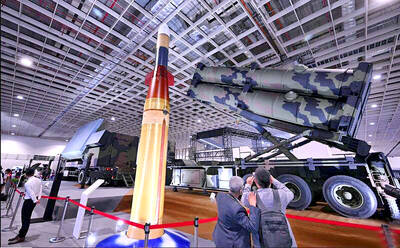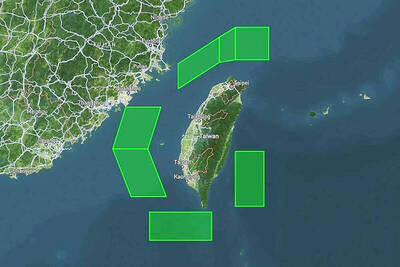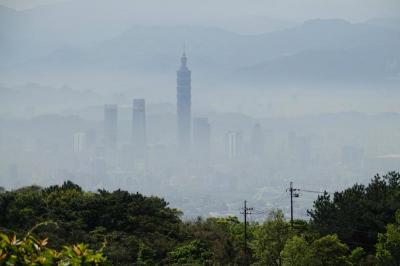In the era of globalization, low production costs and various tax breaks are commonly used as incentives to attract foreign investors, but for Swaziland — the smallest country in the southern hemisphere — another factor, albeit one that is hard to quantify, has been proposed — peace.
“Never, since World War II, have we experienced any kind of war or threat,” Swazi Minister of Economic Planning and Development Hlangusemphi Dlamini said in an interview with Taiwanese reporters visiting the country late last month.
“It is something that makes us proud as a country, something that we can say to the world, maybe if they come and invest and make Swaziland as a destination for Africa, a lot can be achieved,” Dlamimi said.

PHOTO: SHIH HSIU-CHUAN, TAIPEI TIMES
Still, a drop in foreign direct investment (FDI) flowing into Swaziland in recent years has made some officials wonder if peace is not so much a strength as it is a weakness.
“There are opportunities for investors to invest in Swaziland and southern Africa ... but the main thing is people don't know about Africa and Swaziland,” Swazi Minister of Foreign Affairs and International Co-operation Lutfo Ephraim Dlamini said.
Swaziland is a very peaceful country, said Lutfo Ephraim Dlamini, formerly the minister of commerce, industry and trade, “but the problem is, the headlines are about war and fighting, so the peace that we have, the tranquility, has become our disadvantage.”
According to AfricanEconomic-Outlook.org, which combines experts from the African Development Band and other agencies providing data and analysis of 50 African economies, says Swaziland has been adversely affected by the global economic slowdown, as its economy is closely linked to South Africa.
Investment in Swaziland went down in real terms from 20.1 percent of GDP in 2002 to 11.4 percent in 2008 and 10.6 percent last year, the research body said.
Hlangusemphi Dlamini attributed the decline to the sharp appreciation of the South African rand — which the Swazi currency, the lilangeni, is pegged to — since 2002.
“These are things that no one can control,” Hlangusemphi Dlamini said.
With a gradual recovery in the global economy, the Swazi government is trying to highlight its relatively favorable investment climate compared with other countries in Sub-Saharan Africa, with whom Swaziland shares development challenges.
Pointing to South Africa-based Taiwanese textile and apparel manufacturers that will be looking at possible investments in Swaziland this month amid concerns over crime in South Africa, Ambassador to Swaziland Peter Tsai (蔡明耀) said that peace was a characteristic that had strong appeal with foreign investors.
Swaziland’s characterization as a “safe and secure” location for business, families and property is a clear advantage over other African countries, he said.
Another distinguishing feature of Swaziland in terms of investment promotion policy is that it allows full repatriation of profits and dividends of enterprises operating in the country, Tsai said.
“Not many African countries adopt the measure, mostly because of limited foreign exchange reserves. However, this is not a case in Swaziland,” Tsai said, adding that Swaziland has sufficient foreign exchange reserves to sustain a liberalized foreign exchange mechanism.
Lutfo Ephraim Dlamini said the policy was guided by the view in Swaziland that “we believe in this country. You invest your money. You make profits and you are able to take the profits away.”
According to the latest WTO Trade Policy Review on Swaziland published in November last year, FDI inflow in Swaziland fell drastically from about US$67 million between 1990 and 2000 to approximately US$6.6 million between 2003 and 2007.
Swaziland statistics showed that 8 percent of its commercial industry came from Taiwan.
At present, 25 Taiwanese factories operate in Swaziland, mostly textile and garment manufacturers, with an aggregate investment of more than US$90 million, employing about 15,000 people out of a population of 1.35 million, with an unemployment rate of about 40 percent.
Like other governments, Swaziland offers a series of tax deductions to foreign investors, but one of the incentives Taiwanese businesspeople investing in Swaziland find most attractive is that most exports enjoy duty-free access to the US, the EU, as well as the Southern African Development Community and the Common Market for Eastern and Southern Africa.
Swaziland also became a signatory to the preferential trade agreement between the Southern Africa Customs Union (SACU) and MERCUSOR, the Latin American common market composed of Argentina, Brazil, Paraguay and Uruguay, last year.
However, the past decade has seen emerging concerns over gradual losses in preferential treatment granted to foreign manufacturers in African countries.
Mason Ma (馬當正), director and vice president of Tex-Ray Industrial Co, which produces dyed yarns, woven fabrics and garments, said he worried about the expiration in 2015 of the African Growth and Opportunity Act (AGOA), a US trade act that provides duty-free treatment for select apparel articles made in some Sub-Saharan African countries.
“We suffered a blow following the removal of quotas on textile and apparel trade in 2005. When the AGOA expires in 2015, we will lose another form of preferential treatment in terms of tariffs from the US market,” Ma said.
Another manager of a Taiwanese-owned textile and apparel business who wished to remain anonymous said the suspension of the Duty Credit Certificate Scheme (DCCS) in March was expected to cost his company a 15 percent drop in revenue.
The DCCS is an export subsidy for Taiwanese textile industries introduced by SACU in April 1993.
“We hope SACU will come up with new measures to replace the DCCS,” he said.
Chang Wan-li (張萬利), president of the Taiwan Business Association in Swaziland and the president of W.W. Textile, said unstable electricity supply was a major challenge for the country, while fluctuations in electricity prices were also unfavorable to investment.
Another concern for Taiwanese businesses in Swaziland is its rising labor cost, as wages have increased at an average annual rate of between 7 and 12 percent, pushing wage levels higher than in some Southeast Asian countries such as Vietnam and Cambodia, Ma said.
However, Ma said he looked at the positive side, adding that rules and regulations governing employment in Swaziland can better protect labor than those in Taiwan.
An anonymous official with the Swaziland Investment Promotion Authority (SIPA), who was not allowed to speak for the agency, said the SIPA was fully aware of the concerns of Taiwanese businesses and held regular talks to work out solutions to the problems.
“At present, 75 percent of Swaziland’s electricity is bought from South Africa, with 5 percent from Mozambique, but we are now planning to build a power plant,” she said.
In a drive to increase the country's competitiveness and create links between research and industry, the Swazi government is working on building an information, communications and technology park, to be funded through a loan from the Export-Import Bank of India.
Another much larger research and development facility is a science and biotechnology park, with initial funding for its infrastructure design phase coming from the Taiwanese government and the master plan and designs done by CECI Engineering Consultants, Taiwan.
“This is the story of our biotechnology dream. We have a lot of natural resources to develop biotechnology and pharmaceuticals, to make cosmetics and medicine, but we don’t have a research and development facility,” said Moses Zungu, project manager at the Royal Science Technology Park.
“We want to capture some materials we have in the country and add value to them, so that we can make a decent income out of that, to sustain ourselves, to create skills and new products,” Zungu told reporters. “It will change the whole trade landscape for the country.”
Swaziland also aims to boost its tourism industry, with a goal of doubling the number of tourists — currently at 1.3 million — within a year and attracting tourists from continents other than Africa and Europe.
Its new Sikhuphe International Airport is expected to begin operations in December.
Swazi Minister of Tourism, Environment and Communications Thandie Shongwe said his country was looking forward to opening direct flights to and from Taiwan to attract more Taiwanese who are “high on tourism” to explore the culture of the “clean” and “smiling” Swaziland.

Taiwan is to commence mass production of the Tien Kung (天弓, “Sky Bow”) III, IV and V missiles by the second quarter of this year if the legislature approves the government’s NT$1.25 trillion (US$39.78 billion) special defense budget, an official said yesterday. Commenting on condition of anonymity, a defense official with knowledge of the matter said that the advanced systems are expected to provide crucial capabilities against ballistic and cruise missiles for the proposed “T-Dome,” an advanced, multi-layered air defense network. The Tien Kung III is an air defense missile with a maximum interception altitude of 35km. The Tien Kung IV and V

The disruption of 941 flights in and out of Taiwan due to China’s large-scale military exercises was no accident, but rather the result of a “quasi-blockade” used to simulate creating the air and sea routes needed for an amphibious landing, a military expert said. The disruptions occurred on Tuesday and lasted about 10 hours as China conducted live-fire drills in the Taiwan Strait. The Civil Aviation Administration (CAA) said the exercises affected 857 international flights and 84 domestic flights, affecting more than 100,000 travelers. Su Tzu-yun (蘇紫雲), a research fellow at the government-sponsored Institute for National Defense and Security Research, said the air

A strong continental cold air mass is to bring pollutants to Taiwan from tomorrow, the Ministry of Environment said today, as it issued an “orange” air quality alert for most of the country. All of Taiwan except for Hualien and Taitung counties is to be under an “orange” air quality alert tomorrow, indicating air quality that is unhealthy for sensitive groups. In China, areas from Shandong to Shanghai have been enveloped in haze since Saturday, the ministry said in a news release. Yesterday, hourly concentrations of PM2.5 in these areas ranged from 65 to 160 micrograms per cubic meter (mg/m³), and pollutants were

Taiwan’s armed forces have established response protocols for a wide range of sudden contingencies, including the “Wan Chun Plan” to protect the head of state, the Ministry of Defense (MND) said today. After US President Donald Trump on Saturday launched a series of airstrikes in Venezuela and kidnapped Venezuelan President Nicolas Maduro, concerns have been raised as to whether China would launch a similar “decapitation strike” on Taiwan. The armed forces regularly coordinate with relevant agencies and practice drills to ensure preparedness for a wide range of scenarios, Vice Minister of National Defense Hsu Szu-chien (徐斯儉) told reporters before a